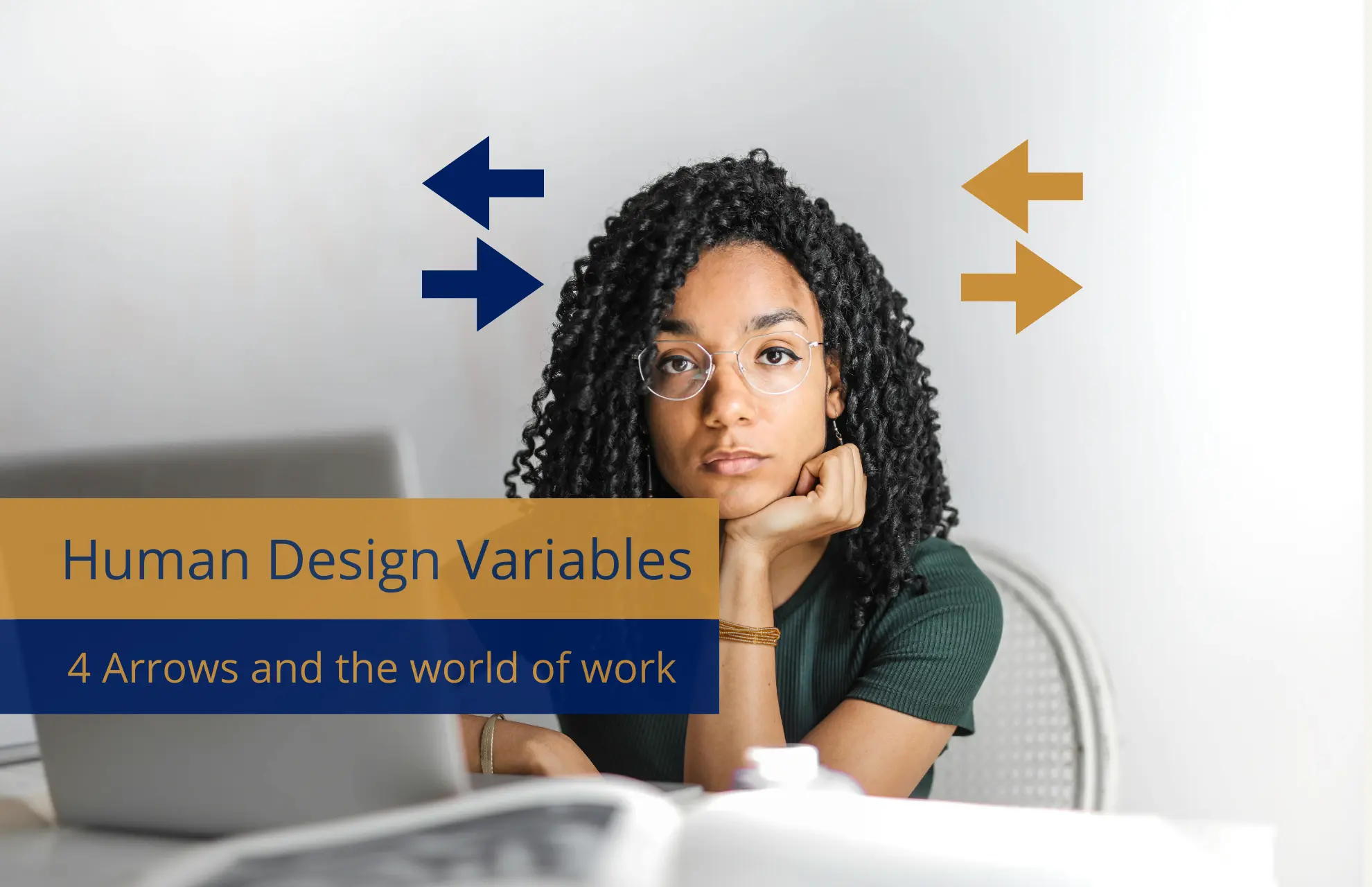The Human Design variables influence how you develop in the world of work and how you interact with your environment. In this blog article, you will find detailed information about the characteristics of the variables and interesting correlations with the development of the world of work.
5 key facts about the Human Design variables
- Definition: The human design variables determine how you process information and interact with your environment – they are the key to your cognitive mode.
- The 4 arrows: Each Human Design Chart has four arrows – they show how you think, perceive, learn and act.
- Left vs. right variables: Left arrows stand for structure, strategy and activity, while right arrows stand for flexibility, intuition and receptivity.
- Evolution of humanity: Humanity is increasingly moving from left (yang) to right (yin) variables – a shift towards more creativity and adaptability.
- Career & future: The human design variables show you how to be successful in the world of work – whether as a strategic planner or an intuitive source of inspiration.
Curious to find out more? Find out more about Human Design variables, their importance for your job and the future of the world of work in the blog!
What are the Human Design Variables?
The Human Design Variables describe the mode of cognitive abilities. This means, on the one hand, how the brain perceives information from the environment and, on the other, how we interact with our fellow human beings. Each person filters information from the environment in a different way. Similar to a radio, which receives different information depending on its location.
The tones – a very deep aspect in your Human Design Chart – of the conscious and unconscious Sun and Earth show you in your Human Design Chart what your brain is like. How you relate to other people is shown by these tones of the Moon nodes on the conscious and unconscious side.

The meaning of the 4 arrows in your Human Design Chart
You will have noticed the arrows pointing to the right and/or left or the ‘Rs’ and ‘Ls’ next to your head in your Human Design Chart. These Human Design variables relate to the activation of the right and left hemispheres of your brain. They relate to the way you process information and interact with people in your environment. Below you will find a description of the characteristics of the left and right arrows of all 4 positions.
The left-hand Human Design Variables (Design Page) describe how you develop in life.
Arrow top left – Activity of your brain (Design Mind)
An arrow pointing to the left indicates an active brain that thinks strategically, logically and consistently. It is about storing what is important for survival (in connection with the spleen centre). Everything that is relevant in life is stored in the working memory.
An arrow pointing to the right indicates a passive brain with a high, holistic and emotional receptivity (connection to the solar plexus centre). There is a high level of receptivity.
Incidentally, the arrow at the top left also has something to do with our digestion, but due to the complexity of the PHS (Primary Health System) in human design, this will not be discussed further here.
Arrow bottom left – Interaction with the environment (design body)
An arrow pointing to the left means that you relate to others in an extroverted way. You approach others freely and involve them in your topic with your proactive charisma.
An arrow pointing to the right indicates an introverted relationship. With this arrow pointing to the right, you exert a certain attraction towards other people because you openly give yourself to them. At the beginning, you passively take part in conversations and wait to see which topic comes up.
The right Human Design Variables (personality) describe how you interact with your environment.
Arrow top right – functioning of the mind and motivation (Personality Mind)
An arrow pointing to the left indicates a strategic mind that only processes the relevant information for your life. You think conceptually and goal-orientated. You often think one step ahead about the information you receive and like to ask further questions.
An arrow pointing to the right indicates a receptive mind that takes in everything there is to take in. This mind processes everything and serves as a resource for your environment.
Arrow bottom right – Perception of the environment (Personality Body)
An arrow pointing to the left means that you are focussing on your surroundings. You are focussing your eyes on something specific.
An arrow pointing to the right means that you favour flexibility and spontaneity in perceiving your surroundings. This means you have a very wide (broad) view without blinkers.

The collective development from the left Human Design Variables to the right variables
Yin and Yang represent duality, yet form a unity.
The concepts of yin and yang express the opposing relationships of everything in the world. So everything has an opposite. Here some examples:

According to Human Design, we are moving towards a yin age. In the interplay of polarities in the development of humanity, yin energy is increasing more and more, while yang energy is steadily decreasing. Yin also stands for the soft, feminine, inspiring and creative.
In contrast, Yang also stands for the hard, masculine, active and for structure and order. And this is where the human design variables come into play. Because the arrows of the variables embody precisely this yin-yang energy. The arrows on the right therefore represent the yin energy, the arrows on the left the yang energy.
As humanity, we are therefore developing into a stronger expression of the right-hand human design variables, but cannot yet completely let go of the left-hand energy until it slips out of our hands at some point. You can find out more about this development from an economic perspective in my blog post ‘Human Design 2027’.
The left and right arrows are not about better or worse. Both are needed so that the world does not fall apart at the seams. So everyone is needed in the world of work and in all other
But how is this development reflected in our economy?
BANI as an acronym for the Yin or R age in business
In the business world, this shift towards yin energy can be described using the acronym BANI. BANI is considered the successor to the acronym VUCA, which stands for volatility, uncertainty, complexity and ambiguity and is used to describe today’s world. The acronym BANI, coined by American futurist and author Jamais Cascio, stands for:
- Brittle: The term brittle is characterised by an apparent robustness that, on closer inspection, does not exist or is outdated. This phenomenon describes systems that appear stable on the outside but have internal weaknesses and are therefore vulnerable.
- Anxious: Anxiousness refers to the increasing uncertainty in decision-making processes, exacerbated by the rapid spread of information, which can lead to paralysis or irrational reactions.
- Non-linear: Non-linearity describes a phenomenon in which cause and effect can no longer be directly linked. Non-linear systems are characterised by unpredictable and often disproportionate reactions to seemingly minor actions.
- Incomprehensible: This term refers to the increasing complexity and incomprehensibility of events or decisions that are characterised by an overload of information and a high level of complexity of the underlying systems.
Approaches to counter BANI or the YIN age
Jamais Cascio proposes the following approaches as to how we can respond to the future described.
- Brittle: In the case of fragility, he advises more elasticity and looseness.
- Anxious: We can counter fear with mindfulness and empathy.
- Non-linear: Non-linearity requires contextualisation and flexibility.
- Incomprehensible: The incomprehensible should become comprehensible through transparency and intuition.
Resilience, i.e. mental resilience, is an important factor that each person must develop individually and on their own responsibility in order to cope as well as possible in the BANI world. Alongside individuality, self-responsibility is also a key issue that we will encounter more and more.
So you can ask yourself how you can surrender to the YIN energy in order to exist in the BANI world without resistance and face the coming chaos in a positive way. With regard to the human design variables, I would like to give you 3 tips for your professional life.
3 tips on how you can integrate the Yin Age into your professional life
- Listen to your inner authority: your body tells you which decision is right for you. Give your mind a break when you make decisions.
- Learn to react more than to act: In the future, we will have less and less opportunity to act according to plan. In chaotic times, flexibility and creativity are required.
- Surrender more and more to life and don’t try to control everything: For many of us, this is easier said than done, as we have all grown up and been brought up in an age of planning. Now is the time to shed these conditionings and beliefs and take a new path.
Conclusion
I hope this blog post has given you a fresh and informative perspective on the human design variables that is new to you and inspires you for your (professional) life.
If you want to know in which direction your variables are pointing, you can use my Human Design Calculator to create your free Human Design Chart. It is important that you enter your birth time very accurately as the Human Design variables are a very subtle aspect that can change within minutes. Click on Human Design Chart and create your chart.
With my Human Design Career Report, I invite you to get to know your Human Design in depth or to find your calling with my Human Design Vocation Course, so that you can lead a future-oriented, meaningful professional life.
What are your thoughts on the Human Design Variables? What else would you like to know? Is there anything important that I have forgotten to mention? Feel free to write it in the comments below.
FAQ: Questions about Human Design Variables
What are Human Design Variables?
What do the 4 arrows mean in Human Design?
These four arrows are the human design variables and relate to how the right and left hemispheres of the brain are activated to process information and how you interact with your environment as a result.






0 Comments